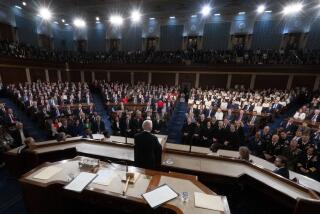Falling Living Standard Cries for Action
- Share via
There is persuasive evidence that the standard of living of the average American worker is declining steadily, and Congress and corporate leaders must act soon to reverse the trend.
The prospects for action could be profoundly affected by the outcome of a hot debate now going on among two economists, a statistician and a politician over a confusing bunch of charts and graphs that are all based on exactly the same statistics.
The debate is about the interpretation, not the accuracy, of the data.
If the politician, Secretary of Labor William E. Brock III, and his followers win the argument by convincing Congress and other powerful forces in this country that their interpretation is right, little will be done to change the course of the economy as it has been charted by the Reagan Adminstration. There are problems, Brock concedes, but in general things are going along pretty well and the system needs only some minor adjustments.
If the statistician, Bureau of Labor Statistics Commissioner Janet Norwood, is the most convincing, we will just keep a close watch as more data accumulates before deciding whether we need a major change of course. She is troubled by the trends, but as of now, she and her followers believe there isn’t enough conclusive evidence to warrant a substantive alteration of the course set by Reagan.
However, the most persuasive arguments come from Barry Bluestone and Bennett Harrison, the economists who wrote a provocative study for the Joint Economic Committee of Congress. Their research clearly shows that Congress and corporate executives should take action soon to put the United States on a healthier road to its economic future.
The argument of the two economists is best summed up by the title of their book, “The Great U Turn: Increasing Inequality in Wage and Salary Income in the U.S.”
Simply put, they warn that the once steadily rising standard of living of most Americans has taken a U-turn and is now headed down.
True, the “Great American Job Machine” is creating millions of new jobs. But, perversely, most of the new jobs pay less than the millions of jobs that have been lost in recent years.
Those much-discussed job losses have come largely in smokestack industries, such as auto, steel and rubber, and in construction and transportation, all of which paid relatively good wages. There have also been some job losses, though, in low-wage industries such as textile and leather.
On the other hand, most of the new jobs are being created in low-wage service industries and the high-tech sector, where wages also tend to be on the low side.
Sadly, the result of the job losses and gains has been pretty much of a standoff: The high unemployment rate of about 7% remains stubbornly stagnant.
The discouraging conclusion to be drawn from the extensive Bluestone-Harrison study is that the newly created, low-paying jobs vastly outnumber the new high-paying ones in the current restructuring of the economy.
This foreshadows a continued reduction in the standard of living of the average worker.
Brock optimistically denounces as a “myth” the contention that high-paying industrial jobs are being rapidly replaced by low-paying service jobs.
The idea that new service jobs “only amount to pushing fast food across a counter is baloney. It just ain’t so,” Brock says.
Norwood, the BLS commissioner, is not so harsh in her evaluation of Bluestone and Harrison. She respects them but thinks it’s too soon to say which direction the U.S. standard of living is headed because of the continuing change in the economy.
She doesn’t dismiss the work of Bluestone and Harrison: “Their figures are absolutely correct. I’m just not sure whether they are right or wrong” in their conclusion about the long-range downward trend of the U.S. standard of living.
After reviewing the criticisms of their study, the economists for the Joint Economic Committee re-evaluated the data and concluded that the situation is, if anything, even worse than they originally said. And their original estimates were bad enough.
In the 1970s, about two out of every 10 new jobs paid $7,000 a year or less.
Since 1979, however, nearly six out of every 10 new jobs paid less than $7,000 a year. The revised figures show the same bleak picture, even when they exclude temporary or part-time jobs, which pay less money annually than full-time jobs.
And there are some other discouraging statistics:
- Average real hourly earnings--based on the purchasing power of the dollar--have dropped nearly 10% since 1972. The drop has been even greater when calculated on the basis of weekly average real earnings.
- The number of workers involuntarily holding part-time jobs is also on the rise. Today, there are nearly 6 million workers who would like to get full-time jobs but cannot find them.
The statistics clearly indicate that Congress should act quickly on trade legislation to ensure that U.S. products are not penalized by unfair, restrictive trade practices abroad. And Congress should take vigorous action against the “dumping” tactic used by some foreign companies--selling products at a loss temporarily in order to increase market share in the long run.
Congress should adopt new job training and retraining programs and laws to cushion the effect of plant closings, especially those that result from takeovers and mergers pushed by corporate raiders.
Business should increase investments in the U.S. instead of exporting jobs, and both business and labor must work harder than ever to increase productivity through cooperative efforts.
If these and other steps are taken, that “Great U-Turn” might take yet another turn and let our standard of living start rising again. After all, there is nothing so un-American as a falling standard of living.
Economists’ Book Tells Golden Rules of Trade
Congress isn’t likely to pass the kind of tough trade bill so urgently sought by organized labor to end the record-breaking series of trade deficits. The new record deficit, the fifth in five years, was $148 billion in 1986.
There will be some kind of trade legislation, but the unions are continuing to press for a more stringent measure. Fearing a misunderstanding of their complex explanations of the effect that the deficit is having on U.S. workers, the AFL-CIO is sending members of Congress copies of an amusing, effective political tract called “The Golden Book of Free Trade Fairy Tales.”
The design and title of the small book is taken from the popular series of Golden Books for children. In the simplest of terms, labor’s version of the children’s book gives some of the reasons that the federation is charging that U.S. trade partners are using unfair rules to win the competition for international business.
For example: “Cars: In the faraway land of Japan, car makers study their latest models, trying to understand the problem. ‘Why aren’t the Italians importing more of our cars? We know that we’re selling a lot of cars in the United States. Do the Italians not like the size? The color?’ In the faraway land of Italy, there is a customs agent who doesn’t really care about size or color because he knows exactly what his job is. He enforces the Golden Rule. And in Italy, the Golden Rule is: “Only 2,200 Japanese cars can enter Italy each year.”
Similar simple explanations of unfair playing rules are given for other products, ranging from fiber optics and steel to computers and even aluminum baseball bats, which are made in America but not allowed for sale in Japan.
Maybe these and other stories are too simplistic, but they do show vividly that the United States needs to take corrective action to make sure that “free trade” is really “fair trade.”
More to Read
Inside the business of entertainment
The Wide Shot brings you news, analysis and insights on everything from streaming wars to production — and what it all means for the future.
You may occasionally receive promotional content from the Los Angeles Times.










